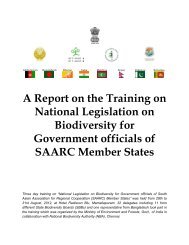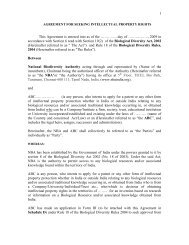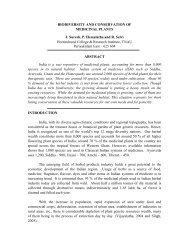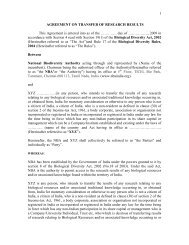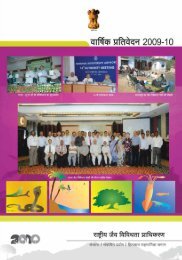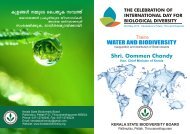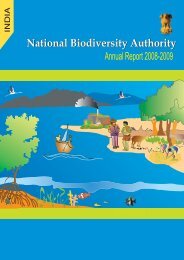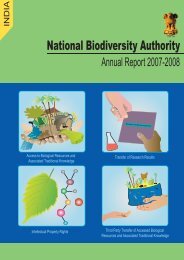Part 1 - English version (PDF) - Convention on Biological Diversity
Part 1 - English version (PDF) - Convention on Biological Diversity
Part 1 - English version (PDF) - Convention on Biological Diversity
Create successful ePaper yourself
Turn your PDF publications into a flip-book with our unique Google optimized e-Paper software.
EXECUTIVE SUMMARY<br />
INDIA’S BIODIVERSITY : STATUS, TRENDS AND THREATS<br />
India, known for its rich heritage of biological diversity, has so far documented over 91,200 species<br />
of animals and 45,500 species of plants in its ten bio-geographic regi<strong>on</strong>s. Besides, it is recognized as <strong>on</strong>e<br />
of the eight Vavilovian centres of origin and diversity of crop plants, having more than 300 wild<br />
ancestors and close relatives of cultivated plants, which are still evolving under natural c<strong>on</strong>diti<strong>on</strong>s. India<br />
is also a vast repository of Traditi<strong>on</strong>al Knowledge (TK) associated with biological resources.<br />
India ranks am<strong>on</strong>g the top ten species-rich nati<strong>on</strong>s and shows high endemism. India has four global<br />
biodiversity hot spots (Eastern Himalaya, Indo-Burma, Western Ghats and Sri Lanka, and Sundaland).<br />
The varied edaphic, climatic and topographic c<strong>on</strong>diti<strong>on</strong>s and years of geological stability have resulted<br />
in a wide range of ecosystems and habitats such as forests, grasslands, wetlands, deserts, and coastal and<br />
marine ecosystem.<br />
Inventories of faunal diversity in India are being progressively updated and analyzed with several new<br />
discoveries. So far, nearly 91,212 of faunal species (7.43% of the world’s faunal species) have been<br />
recorded in the country. Endemic rich Indian fauna is manifested most prominently in Amphibia (61.2%)<br />
and Reptilia (47%). Likewise, Indian fish fauna includes two endemic families and 127 m<strong>on</strong>otypic genera.<br />
As per the Internati<strong>on</strong>al Uni<strong>on</strong> for C<strong>on</strong>servati<strong>on</strong> of Nature (IUCN) Red List (2008), India has 413<br />
globally threatened faunal species, which is approximately 4.9% of the world’s total number of threatened<br />
faunal species.<br />
C<strong>on</strong>tinuous surveys and explorati<strong>on</strong>s have added new discoveries – 41 plant species in 2007 by<br />
Botanical Survey of India (BSI) al<strong>on</strong>e. The unique features of the plant diversity, am<strong>on</strong>g others, include<br />
60 m<strong>on</strong>otypic families and over 6000 endemic species. Recent estimates indicate the presence of over 256<br />
globally threatened plant species in India.<br />
Likewise, India’s c<strong>on</strong>tributi<strong>on</strong> to crop biodiversity has been impressive with repositories of over<br />
50,000 varieties of rice, 5,000 of sorghum, 1,000 varieties of mango, etc. The Nati<strong>on</strong>al Genebank,<br />
primarily resp<strong>on</strong>sible for ex-situ c<strong>on</strong>servati<strong>on</strong> of unique germplasm <strong>on</strong> l<strong>on</strong>g-term basis, holds 3,66,933<br />
unique accessi<strong>on</strong>s of plant genetic resources. India is also endowed with vast and diverse forms of<br />
domesticated animal genetic resources, e.g., cattle, buffalo, sheep, goat, pig, camel, horse, d<strong>on</strong>key, yak,<br />
mithun, duck, goose, quail, etc. Besides, a rich diversity of wild relatives of domesticated animals exists<br />
here. The molecular characterizati<strong>on</strong> has been undertaken so far <strong>on</strong>ly in a few animals such as cattle,<br />
sheep, pig and poultry, using internati<strong>on</strong>ally recommended DNA markers.<br />
India, endowed with vast inland and marine bioresources, is the third largest producer of fish in the<br />
world. A database <strong>on</strong> 2,182 fishes found in Indian waters has been developed, which includes 327 fresh<br />
water species listed in IUCN threat categories and 192 endemic fishes. A macro level fish occurrence map<br />
of India has been prepared and DNA barcodes of 100 Indian marine fish species developed.<br />
1




